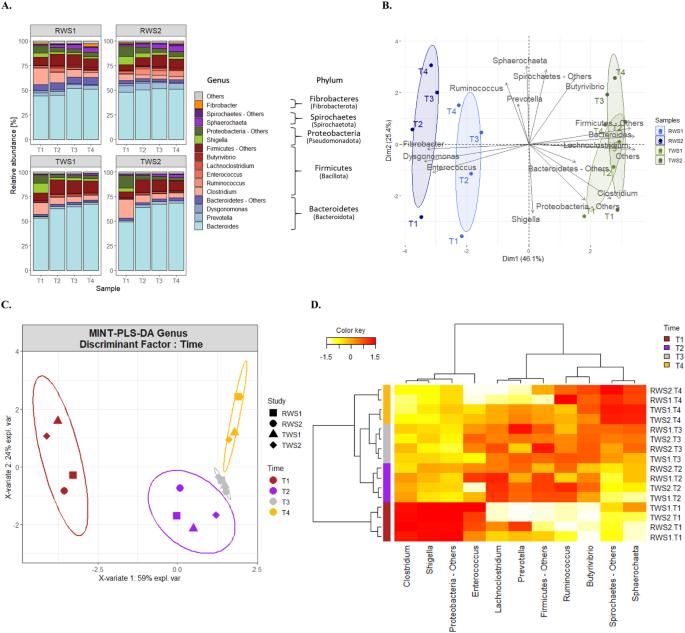Horizontal metaproteomics and CAZymes analysis of lignocellulolytic microbial consortia selectively enriched from cow rumen and termite gut
IF 5.1
Q1 ECOLOGY
引用次数: 0
Abstract
Selectively enriched microbial consortia are potentially useful for the conversion of lignocellulose (LC) into biofuels and commodity chemicals. Consortia are also of interest to elucidate the roles of individual microorganisms and the dynamics of enzymes involved in LC deconstruction. Using metaproteomics, 16 S rRNA gene amplicon sequencing and multivariate discriminant analysis, we revealed the temporal dynamics of microbial species and their proteins during anaerobic conversion of LC by microbial consortia derived from cow rumen (RWS) and termite gut (TWS) microbiomes. Bacteroidetes (Bacteroidota), Firmicutes (Bacillota) and Proteobacteria (Pseudomonadota) phyla were dominant, irrespective the inoculum origin, displaying functional complementarities. We identified a large variety of carbohydrate-active enzymes, distributed in 94 CAZy families, involved in biomass deconstruction. Additionally, proteins involved in short chain fatty acids biosynthesis were detected. Multivariate analysis clearly differentiates RWS and TWS metaproteomes, with differences originating in the initial inoculates. Further supervised discriminant analysis of the temporal succession of CAZymes revealed that both consortia consume easily accessible oligosaccharides during the early stage of incubation, degrading more complex hemicellulose and cellulose fractions at later stages, an action that pursues throughout the incubation period. Our results provide new insights regarding the functional roles and complementarities existing in lignocellulolytic consortia and highlight their potential for biorefinery applications.

从奶牛瘤胃和白蚁肠道中选择性富集的木质纤维素分解微生物联合体的横向元蛋白组学和CAZymes分析
选择性富集微生物联合体可能有助于将木质纤维素(LC)转化为生物燃料和商品化学品。联合体还有助于阐明单个微生物的作用以及参与木质纤维素解构的酶的动态变化。利用元蛋白质组学、16 S rRNA 基因扩增片段测序和多元判别分析,我们揭示了来自奶牛瘤胃(RWS)和白蚁肠道(TWS)微生物群的微生物联合体在厌氧转化液态有机物过程中微生物物种及其蛋白质的时间动态。无论接种物来源如何,类杆菌科(Bacteroidetes)、固着菌科(Firmicutes)和变形菌科(Proteobacteria)均占主导地位,显示出功能互补性。我们发现了大量参与生物质解构的碳水化合物活性酶,它们分布在 94 个 CAZy 家族中。此外,我们还发现了参与短链脂肪酸生物合成的蛋白质。多变量分析明确区分了 RWS 和 TWS 元蛋白组,差异源于初始接种。对 CAZymes 的时间演替进行的进一步监督判别分析显示,这两种菌群都在培养初期消耗容易获得的低聚糖,在后期降解更复杂的半纤维素和纤维素部分,这一过程贯穿整个培养期。我们的研究结果为了解木质纤维素分解联合体的功能作用和互补性提供了新的视角,并凸显了它们在生物精炼应用方面的潜力。
本文章由计算机程序翻译,如有差异,请以英文原文为准。
求助全文
约1分钟内获得全文
求助全文

 求助内容:
求助内容: 应助结果提醒方式:
应助结果提醒方式:


